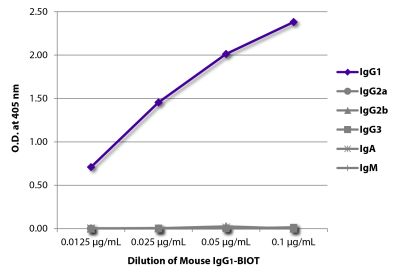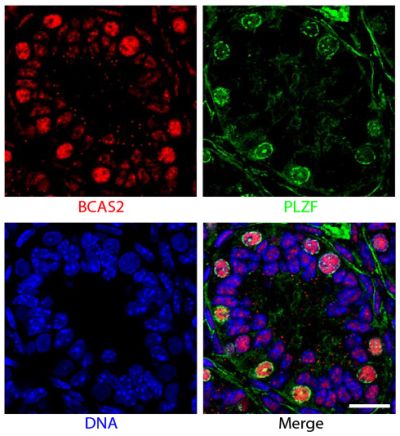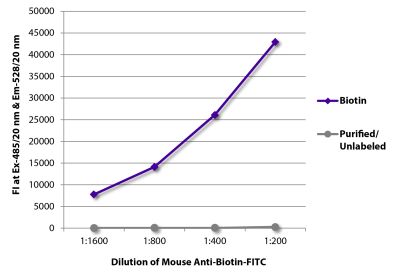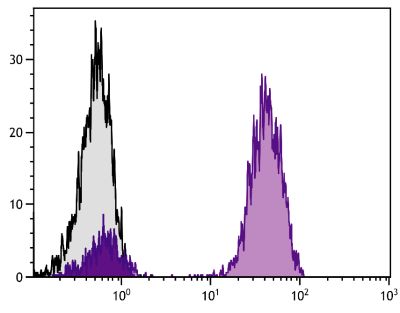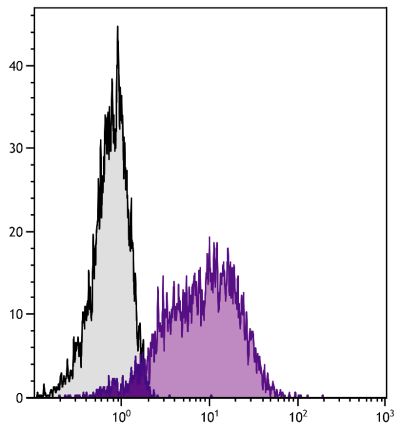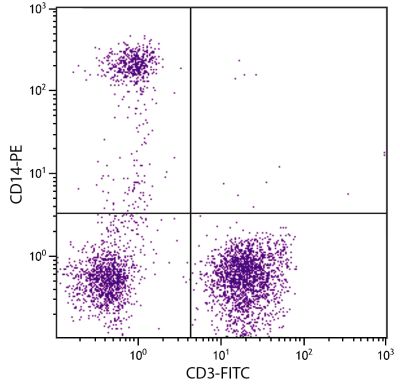Mouse Anti-Human CD106-BIOT (1.G11B1)
Cat. No.:
9510-08
Biotin Anti-Human CD106 antibody for use in flow cytometry, immunohistochemistry / immunocytochemistry, western blot, immunoprecipitation, and ELISA assays.
$183.00
| Clone | 1.G11B1 |
|---|---|
| Isotype | Mouse IgG1κ |
| Isotype Control | Mouse IgG1-BIOT (15H6) |
| Specificity | Human/Porcine CD106 |
| Alternative Names | VCAM-1, INCAM-110, vascular cell adhesion molecule-1 |
| Description | CD106, also known as INCAM-110, is a 110 kDa vascular adhesion cell adhesion molecule-1 (VCAM-1) that is member of the immunoglobulin superfamily. CD106 is expressed predominantly on cytokine-activated vascular endothelium but has also been identified on interfollicular dendritic cells, some macrophages, and bone marrow stromal cells. Endothelial CD106 binds the integrins α4β1 (CD49d/CD29, VLA-4) and α4β7 and contributes to extravasation of lymphocytes, monocytes, basophils, and eosinophils (but not neutrophils) from blood vessels, particularly at sites of inflammation. Unlike the β2 integrins, the CD106-VLA-4 interaction can mediate both the initial tethering and rolling of lymphocytes on endothelium as well as their subsequent arrest and firm adhesion. CD106 expressed on non-vascular tissues has been implicated in the interaction of hematopoietic progenitors with bone marrow stromal cells, B cell binding to follicular dendritic cells, costimulation of T cells, and embryonic development. The monoclonal antibody 1.G11B1 inhibits in vitro binding of lymphocytes and monocytes to VCAM-1 on stimulated endothelium. |
| Conjugate | BIOT (Biotin) |
| Buffer Formulation | Phosphate buffered saline containing < 0.1% sodium azide |
| Clonality | Monoclonal |
| Concentration | Lot specific |
| Volume | 1.0 mL |
| Recommended Storage | 2-8°C |
| Applications |
Flow Cytometry – Quality tested 9-15 Immunohistochemistry-Frozen Sections – Reported in literature 3 Immunocytochemistry – Reported in literature 4,5 Immunoprecipitation – Reported in literature 1 Western Blot-Non-Reducing – Reported in literature 2 ELISA – Reported in literature 1,6-8 Blocking – Reported in literature 1 Adhesion – Reported in literature 1 |
| RRID Number | AB_2796824 |
| Gene ID |
7412 (Human) 396925 (Porcine) |
| Gene ID Symbol |
VCAM1 (Human) VCAM1 (Porcine) |
| Gene ID Aliases | CD106; INCAM-100 |
| UniProt ID |
P19320 (Human) |
| UniProt Name |
VCAM1_HUMAN (Human) |
Documentation
Certificate of Analysis Lookup
Enter the Catalog Number and Lot Number for the Certificate of Analysis you wish to view
- 1. Thornhill MH, Wellicome SM, Mahiouz DL, Lanchbury JS, Kyan-Aung U, Haskard DO. Tumor necrosis factor combines with IL-4 or IFN-γ to selectively enhance endothelial cell adhesiveness for T cells. The contribution of vascular cell adhesion molecule-1-dependent and -independent binding mechanisms. J Immunol. 1991;146:592-8. (ELISA, IP, Adhesion, Block)
- 2. Ali S, Kaur J, Patel KD. Intercellular cell adhesion molecule-1, vascular cell adhesion molecule-1, and regulated on activation normal T cell expressed and secreted are expressed by human breast carcinoma cells and support eosinophil adhesion and activation. Am J Pathol. 2000;157:313-21. (WB-NR)
- 3. Jain A, Sharma MC, Sarkar C, Bhatia R, Singh S, Handa R. Increased expression of cell adhesion molecules in inflammatory myopathies: diagnostic utility and pathogenetic insights. Folia Neuropathol. 2009;47:33-42. (IHC-FS)
- 4. Lin Y, Weisdorf DJ, Solovey A, Hebbel RP. Origins of circulating endothelial cells and endothelial outgrowth from blood. J Clin Invest. 2000;105:71-7. (ICC)
- 5. Halfon S, Abramov N, Grinblat B, Ginis I. Markers distinguishing mesenchymal stem cells from fibroblasts are downregulated with passaging. Stem Cells Dev. 2011;20:53-66. (ICC)
- 6. Kalogeris TJ, Laroux FS, Cockrell A, Ichikawa H, Okayama N, Phifer TJ, et al. Effect of selective proteasome inhibitors on TNF-induced activation of primary and transformed endothelial cells. Am J Physiol. 1999;276(4):C856-64. (ELISA)
- 7. Kalogeris TJ, Kevil CG, Laroux FS, Coe LL, Phifer TJ, Alexander JS. Differential monocyte adhesion and adhesion molecule expression in venous and arterial endothelial cells. Am J Physiol. 1999;276:L9-19. (ELISA)
- 8. Lester EA, Babensee JE. Proinflammatory phenotype of endothelial cells after coculture with biomaterial-treated blood cells. J Biomed Mater Res A. 2003;64:397-410. (ELISA)
- 9. Yamamoto H, Sedgwick JB, Busse WW. Differential regulation of eosinophil adhesion and transmigration by pulmonary microvascular endothelial cells. J Immunol. 1998;161:971-7. (FC)
- 10. Nohé B, Dieterich H, Eichner M, Unertl K. Certain batches of albumin solutions influence the expression of endothelial cell adhesion molecules. Intensive Care Med. 1999;25:1381-5. (FC)
- 11. Yamamoto H, Sedgwick JB, Vrtis RF, Busse WW. The effect of transendothelial migration on eosinophil function. Am J Respir Cell Mol Biol. 2000;23:379-88. (FC)
- 12. Lazzeri E, Crescioli C, Ronconi E, Mazzinghi B, Sagrinati C, Netti GS, et al. Regenerative potential of embryonic renal multipotent progenitors in acute renal failure. J Am Soc Nephrol. 2007;18:3128-38. (FC)
- 13. Mariucci S, Rovati B, Bencardino K, Manzoni M, Danova M. Flow cytometric detection of circulating endothelial cells and endothelial progenitor cells in healthy subjects. Int J Lab Hematol. 2008;32:e40-8. (FC)
- 14. Weckbach LT, Gola A, Winkelmann M, Jakob SM, Groesser L, Borgolte J, et al. The cytokine midkine supports neutrophil trafficking during acute inflammation by promoting adhesion via β2 integrins (CD11/CD18). Blood. 2014;123:1887-96. (FC)
- 15. Moscoso I, Centano A, López E, Rodriguez-Barbosa JI, Santamarina I, Filgueira P, et al. Differentiation "in vitro" of primary and immortalized porcine mesenchymal stem cells into cardiomyocytes for cell transplantation. Transplant Proc. 2005;37:481-2. (FC, Porcine Reactivity)
See More


